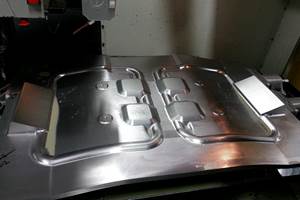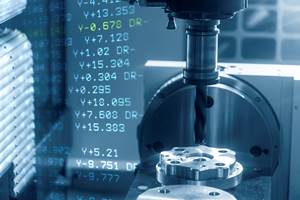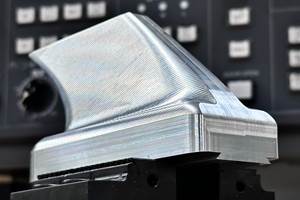4 Manufacturing Trends That Cannot Be Ignored
The next five years will present their own unique set of challenges, and shops can alleviate them by embracing these technologies and trends.
Share





If you own a machine shop or work as a machinist, you likely have experienced many challenges over the past five years. We’ve all faced numerous difficulties, and the most significant challenges during this period were material supply shortages and business volatility due to the pandemic. Many companies struggled to overcome these obstacles and ultimately failed, while those that persevered found the journey difficult but managed to stay afloat.
The next five years will present their own unique set of challenges, and a significant portion of them will be driven by the challenge to embrace technology and trends. Many of these technologies and trends are not novel, but have become increasingly crucial for machine shops to address — ignoring them is no longer an option.
Some of the major technologies and trends that must be embraced are:
Automation and Robotics
Many shops have resisted automation and robotics, but it’s the most necessary for a shop to embrace. Productivity is key, and without automation and robotics, shops will fall further behind those that do embrace it. The skilled labor shortage isn’t going away, and finding skilled labor will become harder and more expensive. Automation and robotics are key to maximizing the productivity of existing skilled labor and keeping costs down.
It’s also worth noting that simple automation and robotics have become easier for shops to implement than ever before. Robotics and automation is even being taught in high schools, and teenagers know how to use it. Young people see automation technology as being the future, yet many companies still aren’t embracing it. Ignoring this technology is no longer an option, since future skilled workers will no longer be attracted to shops that do not have it.
Additive Manufacturing
I had initially thought that additive manufacturing (AM) had limited uses, but I was wrong. I didn’t realize the many hidden uses it had in manufacturing beyond just competing directly with subtractive manufacturing. One of the most remarkable uses is in fixture design for manufacturing and quality control. AM has made it easy to create quick fixtures in our machine shops, and holding complex shapes for measuring and machining has become a breeze.
Additionally, it seems like almost every household I know has a 3D printer. There are many affordable options for shops and they can help produce significant productivity enhancements. AM can no longer be ignored, because it adds to the tools and capabilities available for a shop to be more competitive now and the future.
Artificial Intelligence
Artificial intelligence (AI) has emerged as a significant player in the machining industry, and it is often misunderstood. Initially, AI was cumbersome and complex to understand and use, but its rapid advancement has transformed it into an integral component and tool in various manufacturing processes. From design and programming to scheduling and modeling, AI finds applications across the machining spectrum. Its impact continues to amaze me as I discover new areas where it influences our industry.
For instance, AI ensures that machines are turned on at the appropriate time for warm up and provide a confirmation of the task being accomplished. It helps stock the right tools for specific jobs through analyzing the work backlog and suggesting the right tools to increase throughput. It also facilitates programming advanced machining strategies.
The uses for AI are just getting started and will increase every day, and organizations embracing AI are discovering innovative methods to boost productivity daily. Failing to embrace AI risks shops being left behind quickly in the competitive machining landscape.
Modularity (Nimble Production)
Another emerging trend is modularity, characterized by the ability to swiftly transition between different manufacturing processes. This approach involves designing and constructing complex systems using smaller, interchangeable components or modules. For job shops, modularity means utilizing standardized tooling fixtures and machines that can be quickly reconfigured to accommodate various work orders. This contrasts with the traditional method of machining, where custom setups are employed for each unique task, resulting in longer setup times and reduced equipment utilization.
Two machine shops with the same equipment can have vastly different productivity outcomes when one adopts a quick-changing, standardized modular process. This approach allows the one that has adopted modularity to have faster job changeovers, leading to increased productivity and higher quality. The era of complex setups is quickly being replaced by quick-change, modular workholding and processes, which is driven by the need to become more competitive. This game-changing innovation and technology demands immediate adoption to avoid falling behind.
Many shops that haven’t started to embrace these technologies may face a bleak future. Adoption of these technological trends is becoming the norm as shops struggle to keep up with the rapid pace of change in the competitive landscape. Embrace these technologies and trends as soon as possible — better yet, start now!
Related Content
4 Tips for Staying Profitable in the Face of Change
After more than 40 years in business, this shop has learned how to adapt to stay profitable.
Read More4 Commonly Misapplied CNC Features
Misapplication of these important CNC features will result in wasted time, wasted or duplicated effort and/or wasted material.
Read MoreTips for Designing CNC Programs That Help Operators
The way a G-code program is formatted directly affects the productivity of the CNC people who use them. Design CNC programs that make CNC setup people and operators’ jobs easier.
Read MoreCustom Workholding Principles to Live By
Workholding solutions can take on infinite forms and all would be correct to some degree. Follow these tips to help optimize custom workholding solutions.
Read MoreRead Next
Last Chance! 2025 Top Shops Benchmarking Survey Still Open Through April 30
Don’t miss out! 91ÊÓƵÍøÕ¾ÎÛ's Top Shops Benchmarking Survey is still open — but not for long. This is your last chance to a receive free, customized benchmarking report that includes actionable feedback across several shopfloor and business metrics.
Read MoreAMRs Are Moving Into Manufacturing: 4 Considerations for Implementation
AMRs can provide a flexible, easy-to-use automation platform so long as manufacturers choose a suitable task and prepare their facilities.
Read MoreMachine Shop MBA
Making Chips and 91ÊÓƵÍøÕ¾ÎÛ are teaming up for a new podcast series called Machine Shop MBA—designed to help manufacturers measure their success against the industry’s best. Through the lens of the Top Shops benchmarking program, the series explores the KPIs that set high-performing shops apart, from machine utilization and first-pass yield to employee engagement and revenue per employee.
Read More






















